RBSE Solutions for Class 6 Maths Chapter 10 Mensuration Ex 10.1
Rajasthan Board RBSE Solutions for Class 6 Maths Chapter 10 Mensuration Ex 10.1 Textbook Exercise Questions and Answers.
Rajasthan Board RBSE Solutions for Class 6 Maths in Hindi Medium & English Medium are part of RBSE Solutions for Class 6. Students can also read RBSE Class 6 Maths Important Questions for exam preparation. Students can also go through RBSE Class 6 Maths Notes to understand and remember the concepts easily. Students are advised to practice अनुपात और समानुपात के प्रश्न class 6 of the textbook questions.
RBSE Class 6 Maths Solutions Chapter 10 Mensuration Ex 10.1
Question 1.
Find the perimeter of each of the following figures:
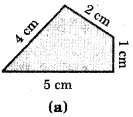
Answer:
Perimeter
= 4 cm + 2 cm + 1 cm + 5 cm
= 12 cm.

Answer:
Perimeter
= 35 cm + 23 cm + 35 cm + 40 cm
= 133 cm.
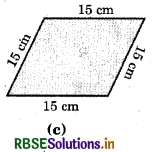
Answer:
Perimeter
= 15 cm + 15 cm + 15 cm + 15 cm
= 60 cm.
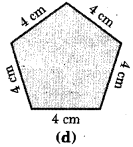
Answer:
Perimeter .
= 4 em + 4cm+ 4cm + 4cm + 4cm
= 20 cm.
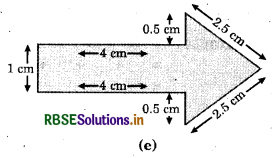
Answer:
Perimeter
= 1 cm + 4 cm + 0.5 cm + 2.5 cm + 2.5 cm + 0.5 cm + 4 cm
= 15 cm.
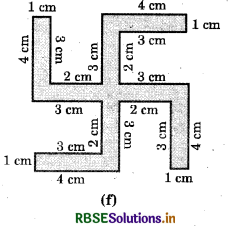
Answer:
Perimeter
= 1 cm + 3cm + 2cm + 3 cm + 4cm + lcm + 3cm + 2 cm + 3 cm + 4 cm + 1 cm + 3 cm + 2 cm + 3 cm + 4 cm + 1 cm + 3cm + 2cm + 3cm + 4cm
= 52 cm.

Question 2.
The lid of a rectangular box of sides 40 cm by 10 cm is sealed all round with tape. What is the length of the tape required?
Answer:
Given that
Length of rectangular box = 40 cm
Breadth = 10 cm
Length of tape required
= Perimeter of rectangular box = 2 × (length + breadth)
= 2 × (40 cm + 10 cm)
= 2 × 50 cm = 100 cm = 1 m.
Thus, 1 m length of tape is required.
Question 3.
A table-top measures 2 m 25 cm by 1 m 50 cm. What is the perimeter of the table-top?
Answer:
Length of the table-top
= 2 m 25 cm = 2.25 m
Breadth of the table-top
= 1 m 50 Cm = 1.50 m
∴ Perimeter = 2 (length + breadth)
= 2 (2.25 m + 1.50 m)
= 2 (3.75 m) = 7.50 m.
Question 4.
What is the length of the wooden strip required to frame a photograph of length and breadth 32 cm and 21 cm respectively?
Answer:
Length of photograph = 32 cm
Breadth = 21 cm
Length of wooden strip required = Perimeter of rectangular photograph frame
= 2 × (l + b) = 2 × (32 + 21) cm.
= 2 × 53 = 106 cm.
Question 5.
A rectangular piece of land measures 0.7 km by 0.5 km. Each side is to be fenced with 4 rows of wires. What is the length of the wire needed?
Answer:
Length of rectangular piece of land = 0.7 km
Breadth = 0.5 km
Length of wire needed for 1 row of wire
= Perimeter of rectangular land = 2 × (length + breadth)
= 2 × (0.7 + 0.5) km
= 2 × 1.2 km = 2.4 km
∴ Length of wire needed for 4 rows of wire
= 4 × 2.4 km = 9.6 km.

Question 6.
Find the perimeter of each of the following shapes:
(a) A triangle of sides 3 cm, 4 cm and 5 cm.
Answer:
Perimeter of triangle
= 3 cm + 4 cm + 5 cm = 12 cm.
(b) An equilateral triangle of side 9 cm.
Answer:
Perimeter of an equilateral triangle
= 3 × side = 3 × 9 cm = 27 cm.
(c) An isosceles triangle with equal sides 8 cm each and third side 6 cm.
Answer:
Perimeter of the isosceles triangle
= 8 cm + 8 cm + 6 cm = 22 cm.
Question 7.
Find the perimeter of a triangle with sides measuring 10 cm, 14 cm and 15 cm.
Answer:
Perimeter of a triangle
= 10 cm + 14 cm + 15 cm = 39 cm.
Question 8.
Find the perimeter of a regular hexagon with each side measuring 8 m.
Answer:
∵ Length of each side of hexagon = 8 m
Perimeter of regular hexagon
= 6 × length of each side = 6 × 8m = 48m
Question 9.
Find the side of the square whose perimeter is 20 m.
Answer:
Given that
Perimeter of square = 20 m
⇒ 4 × Side = 20 m
⇒ Side = \(\frac{20}{4}\)m = 5m.

Question 10.
The perimeter of a regular pentagon is 100 cm. How long is its each side?
Answer:
Given that
Perimeter of regular pentagon = 100 cm
⇒ 5 × Length of each side = 100
⇒ Length of each side = \(\frac{100}{5}\)
= 20 cm.
Question 11.
A piece of string is 30 cm long. What will be the length of each side if the string is used to form :
(a) a square?
Answer:
Length of string = 30 cm
∵ Perimeter of a square = 4 × Length of side
∴ Length of each side
= \(\frac{\text { Perimeter of square }}{4}\)
= \(\frac{30}{3}\) = 10 cm.
(b) an equilateral triangle?
Answer:
∵ Perimeter of an equilateral triangle
= 3 × Length of each side
∴ Length of each side
= \(\frac{\text { Perimeter of equilateral triangle }}{3} \)
= \(\frac{30}{3}\) = 10 cm.
(c) a regular hexagon?
Answer:
∵ Perimeter of regular hexagon
= 6 × Length of each side
∴ Length of each side
= \(\frac{\text { Perimeter of equilateral triangle }}{6} \)
= \(\frac{30}{6}\) = 5 cm.

Question 12.
Two sides of a triangle are 12 cm and 14 cm. The perimeter of the triangle is 36 cm. What is its third side?
Answer:
Perimeter of triangle
= Sum of lengths of all the three sides
Let the third side be x cm, then
36 = 12 + 14 + x
⇒ 36 = 26 + x
⇒ x = 36 - 26 = 10 cm.
Hence, third side of the triangle be 10 cm.
Question 13.
Find the cost of fencing a square park of side 250 m at the rate of ₹ 20 per metre.
Answer:
Side of square park = 250 m
∴ Perimeter of square park
= 4 × length of each side = 4 × 250 m = 1000 m.
∴ Cost of fencing the square park at the rate of ₹ 20 per metre
= ₹ 20 × 1000 = ₹ 20,000
Question 14.
Find the cost of fencing a rectangular park of length 175 m and breadth 125 m at the rate of ₹ 12 per metre.
Answer:
Length of rectangular park = 175 m
Breadth = 125 m
∴ Perimeter of the rectangular park = 2 × (length + breadth)
= 2 (175 + 125) m = 2 (300)m = 600 m
∴ Cost of fencing the rectangular park at the rate of ₹ 12 per metre
= ₹ 12 × 600 = ₹ 7,200
Question 15.
Sweety runs around a square park of side 75 m. Bulbul runs around a rectangular park with length 60 m and breadth 45 m. Who covers less distance?
Answer:
Distance covered by Sweety
= Perimeter of the square park
= 4 × length of each side
= 4 × 75 m = 300 m.
Distance covered by Bulbul
= Perimeter of rectangular park
= 2 × (length + breadth)
= 2 × (60 + 45) m
= 2 × 105 m = 210 m.
Hence, Bulbul covers less distance.

Question 16.
What is the perimeter of each of the following figures? What do you infer from the answers?
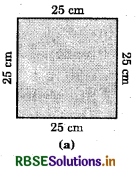
Answer:
Perimeter
= Sum of lengths of all sides
= 25 cm + 25 cm + 25 cm + 25 cm
= 100 cm.
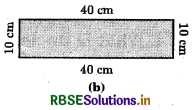
Answer:
Perimeter
= Sum of lengths of all sides
= 10 cm + 40 cm + 10 cm + 40 cm
= 100 cm.
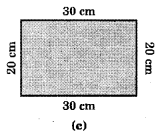
Answer:
Perimeter
= Sum of lengths of all sides
= 30 cm + 20 cm + 30 cm + 20 cm
= 100 cm.
Inference from the answers : All the figures have the same perimeter.

Question 17.
Avneet buys 9 square paving slabs, each with a side of \(\frac{1}{2}\)m. He lays them in the form of a square.
(a) What is the perimeter of his arrangement [fig. (i)]?
(b) Shari does not like his arrange¬ment. She gets him to lay them out like a cross. What is the perimeter of her arrangement [fig. (ii)]?
(c) Which arrangement has greater perimeter?
(d) Avneet wonders if there is a way of getting an even greater perimeter. Can ypu find a way of doing this? (The paving slabs must meet along complete edges, i.e. they cannot he broken.)
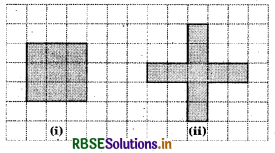
Answer:
(a) Perimeter of this arrangement = 4 × length of each side
= 4 × (\(\frac{1}{2}\)m + \(\frac{1}{2}\)m + \(\frac{1}{2}\)m) = 4 × \(\frac{3}{2}\)m
= 6m.
(b) Perimeter of Shari's arrangement = \(\frac{1}{2}\)m + (\(\frac{1}{2}\)m + \(\frac{1}{2}\)m) + (\(\frac{1}{2}\)m + \(\frac{1}{2}\)m) + \(\frac{1}{2}\)m 2m + 2m(2m + 2m) + 2m
= 10 m.
(c) Cross arrangement has greater perimeter.
(d) Yes! There is a way of getting an even greater perimeter;

Side of each square = \(\frac{1}{2}\) m
Length of rectangle = \(\frac{9}{2}\)m
Breadth of rectangle = \(\frac{1}{2}\) m
Perimeter = 2 (l + b)
= 2\(\left(\frac{9}{2}+\frac{1}{2}\right)=2 \times \frac{10}{2}\)
= 10 m.

- RBSE Solutions for Class 6 Maths Chapter 2 Whole Numbers InText Questions
- RBSE Class 6 Maths Important Questions Chapter 1 अपनी संख्याओं की जानकारी
- RBSE Solutions for Class 6 Maths Chapter 7 भिन्न Intext Questions
- RBSE Solutions for Class 6 Maths Chapter 7 Fractions Ex 7.4
- RBSE Solutions for Class 6 Maths Chapter 1 Knowing our Numbers Ex 1.1
- RBSE Solutions for Class 6 Maths Chapter 1 Knowing our Numbers InText Questions
- RBSE Solutions for Class 6 Maths in Hindi Medium & English Medium
- RBSE Solutions for Class 6 Maths Chapter 7 Fractions InText Questions
- RBSE Solutions for Class 6 Maths Chapter 7 Fractions Ex 7.6
- RBSE Solutions for Class 6 Maths Chapter 7 Fractions Ex 7.5
- RBSE Solutions for Class 6 Maths Chapter 7 Fractions Ex 7.3